- Author: Kathy Keatley Garvey
That lady beetle, aka ladybug, that landed on the shoe of San Francisco 49”ers wide receiver Brandon Aiyuk just before the NFL championship game, apparently didn't show up at the Super Bowl.
The 49'ers lost to the Kansas City Chiefs, but what a great battle it was.
Do lady beetles bring good luck?
Maybe. Maybe not.
But we always appreciate them, especially on Valentine's Day. They're red, they gobble aphids, and sometimes they represent love.
This group of enthusiastic beetles (below) had just been devouring aphids on a brittlebush (Encelia farinosa), on the UC Davis campus back in 2014, and then it happened. Three formed a Leaning Tower of Pisa.
The end result: More beneficial insects soon!
Happy Valentine's Day!

- Author: Kathy Keatley Garvey
Happy Valentine's Day!
While everyone else hands out little pink candy conversation hearts proclaiming "Bee Mine," "Miss You," "Call Me," "Kiss Me," and "I Love You," insect enthusiasts post photos of bugs "keeping busy."
We spotted an unforgettable scene recently in a flower patch behind the UC Davis Lab Sciences Building. The ladybugs (actually they're "lady beetles" because they're not bugs) were devouring aphids on the brittlebush (Encelia farinosa), a desert shrub we see throughout California, northwestern Mexico and the southwestern United States.
Quite contentedly, we might add. And doing a great job, we might also add.
But that's not all they were doing.
Brittlebush makes a good dining room, living room and bedroom.
Soon the flower patch will turn into a nursery.

- Author: Kathy Keatley Garvey
What's for lunch?
If you're a lady beetle (aka ladybug), a good bet is you'll have one of those yummy, plant-sucking aphids. In fact, you'll eat your fill. Please do.
Today we walked behind the Life Sciences Building on the UC Davis campus and encountered scores of our polka-dotted, six-legged, dome-shaped buddies hunting for prey.
It was easy pickings.
This was a fast predator in a slow food movement.
Aphids were everywhere on the brittlebush (Encelia farinosa).
Call lady beetles what you will. Ladybirds. Lady beetles. Ladybugs. Coccinelles. Beneficial insects. All of the above.
Most people in America, however, know this insect as a "ladybug." It's actually not a true bug but a beetle. It's a member of the Coccinellidae family. Coccinelid is Latin for "scarlet," but not all lady beetles are scarlet with black spots. Some are yellow, orange and brown, and some with spots and some without.
You'll find coccinellids worldwide as there are more than 5,000 species, and of that number, more than 450 are native to North America, according to Wikipedia.
And they all "do lunch" with aphids, scales and other soft-bodied insects.





